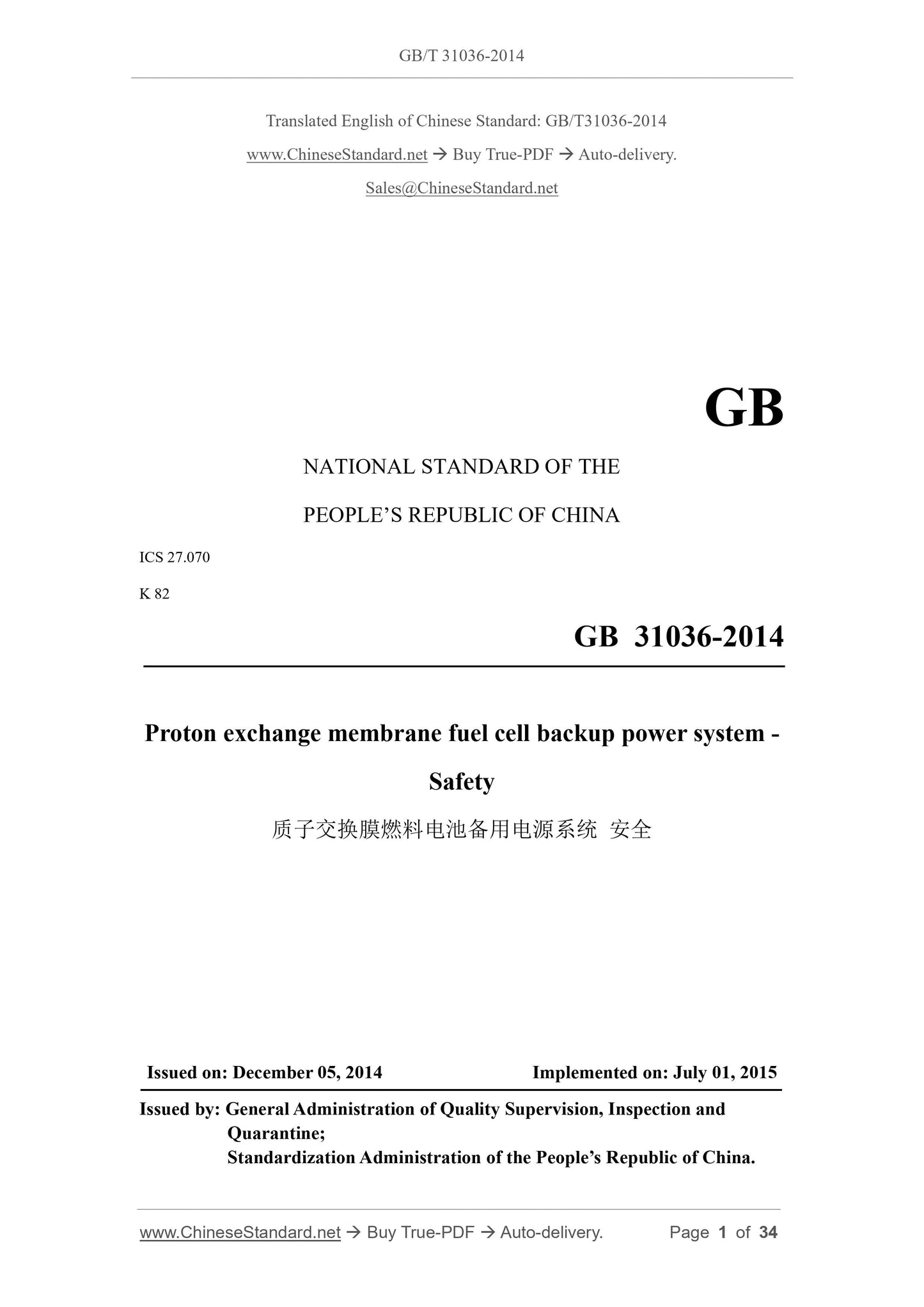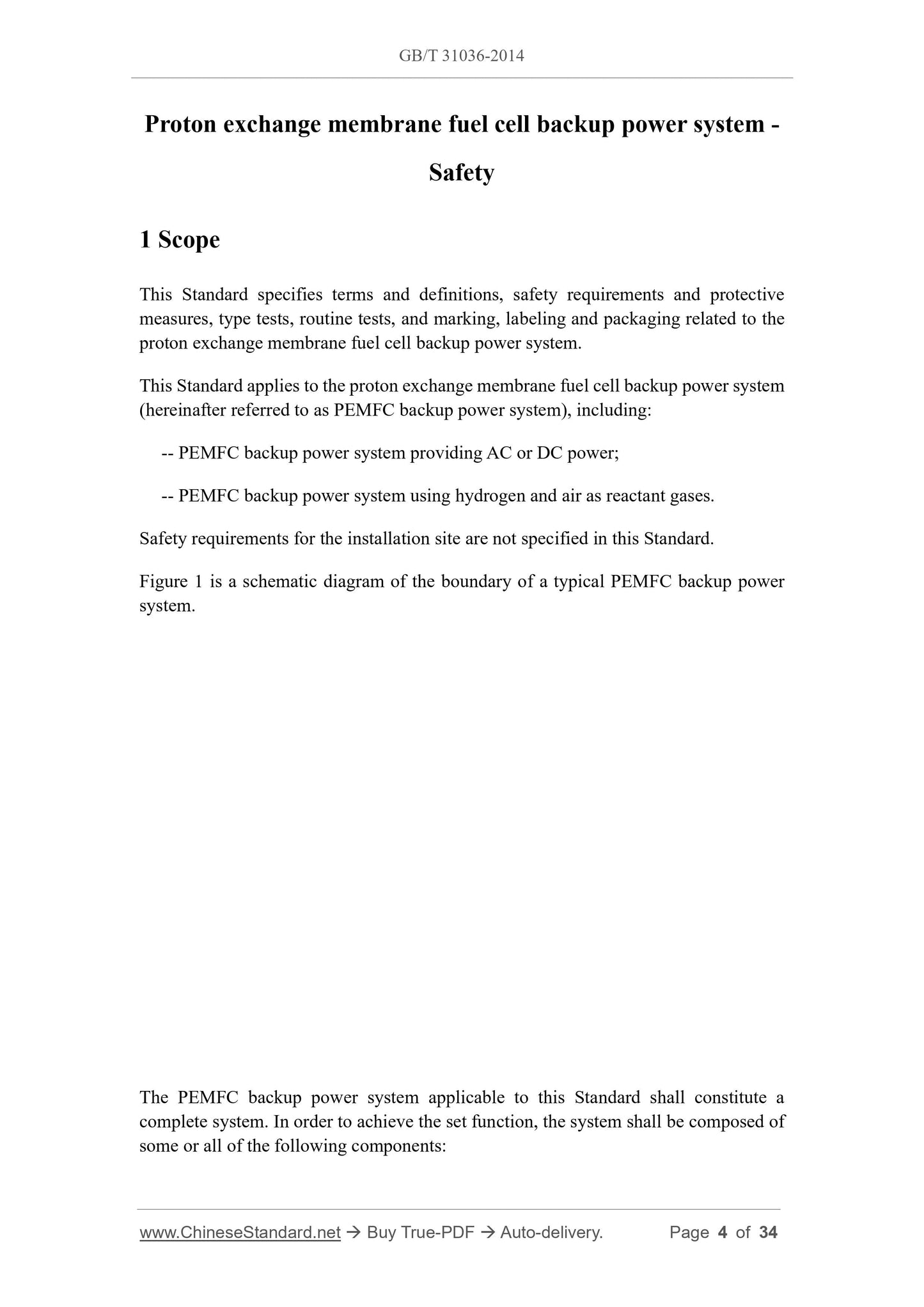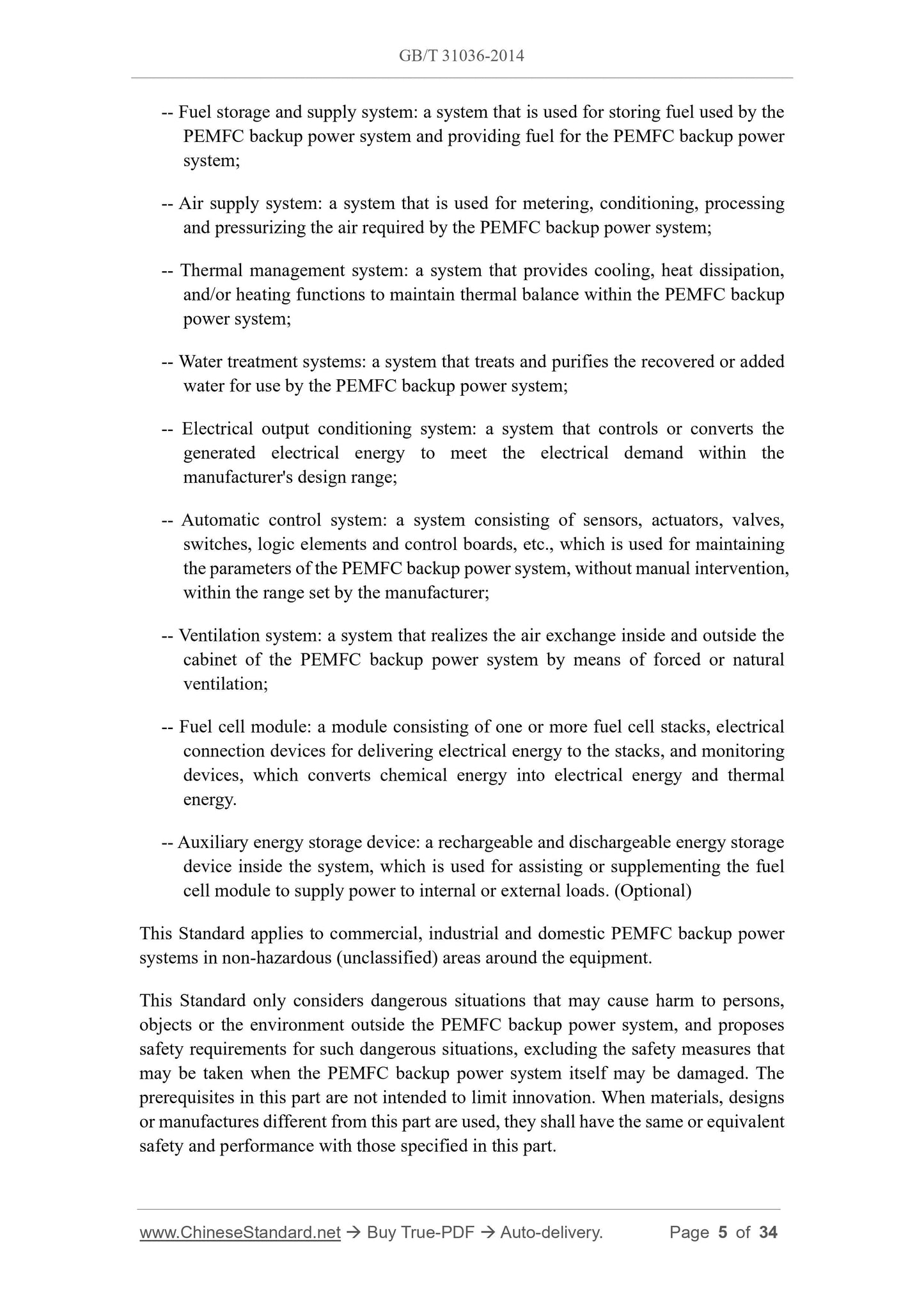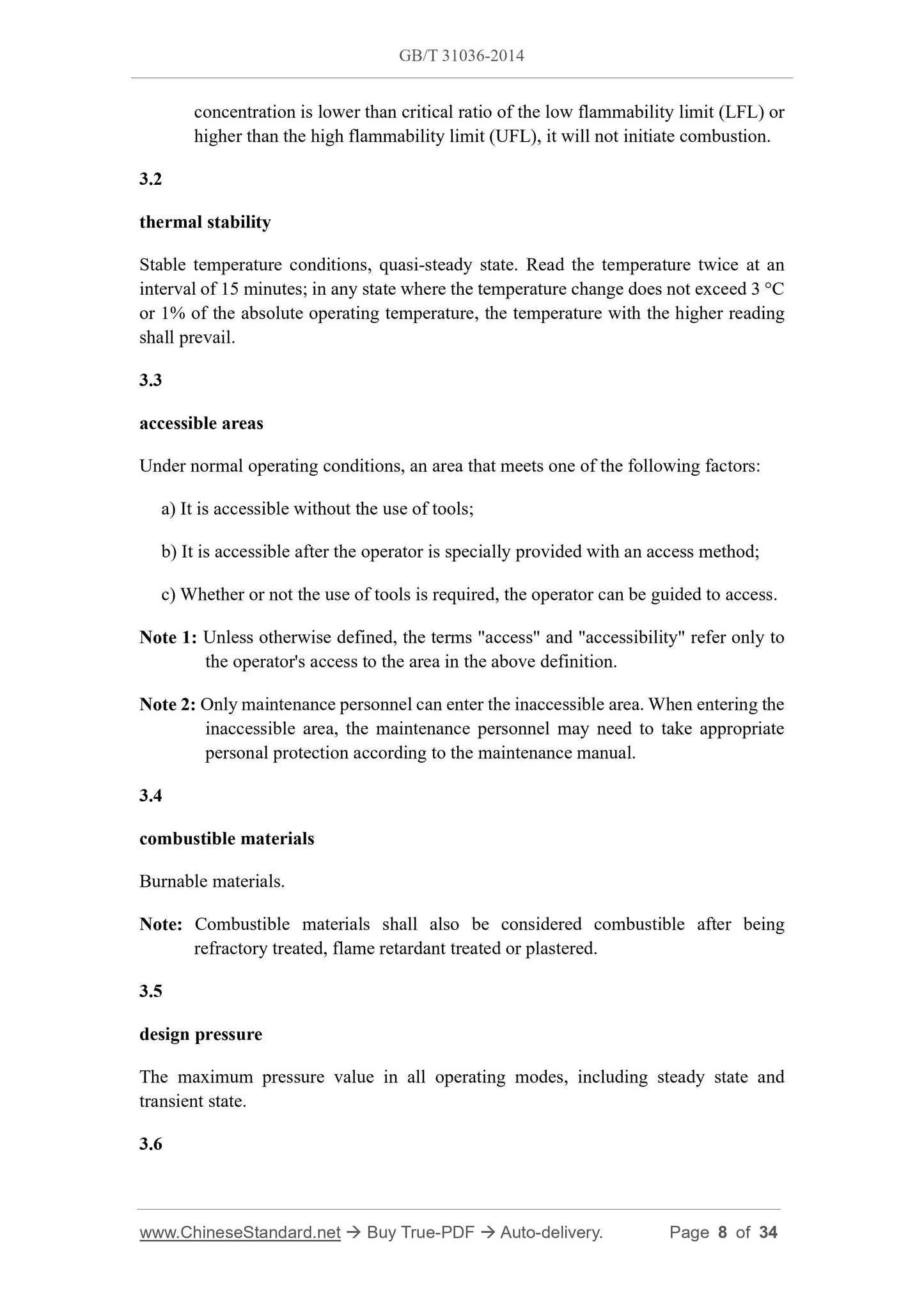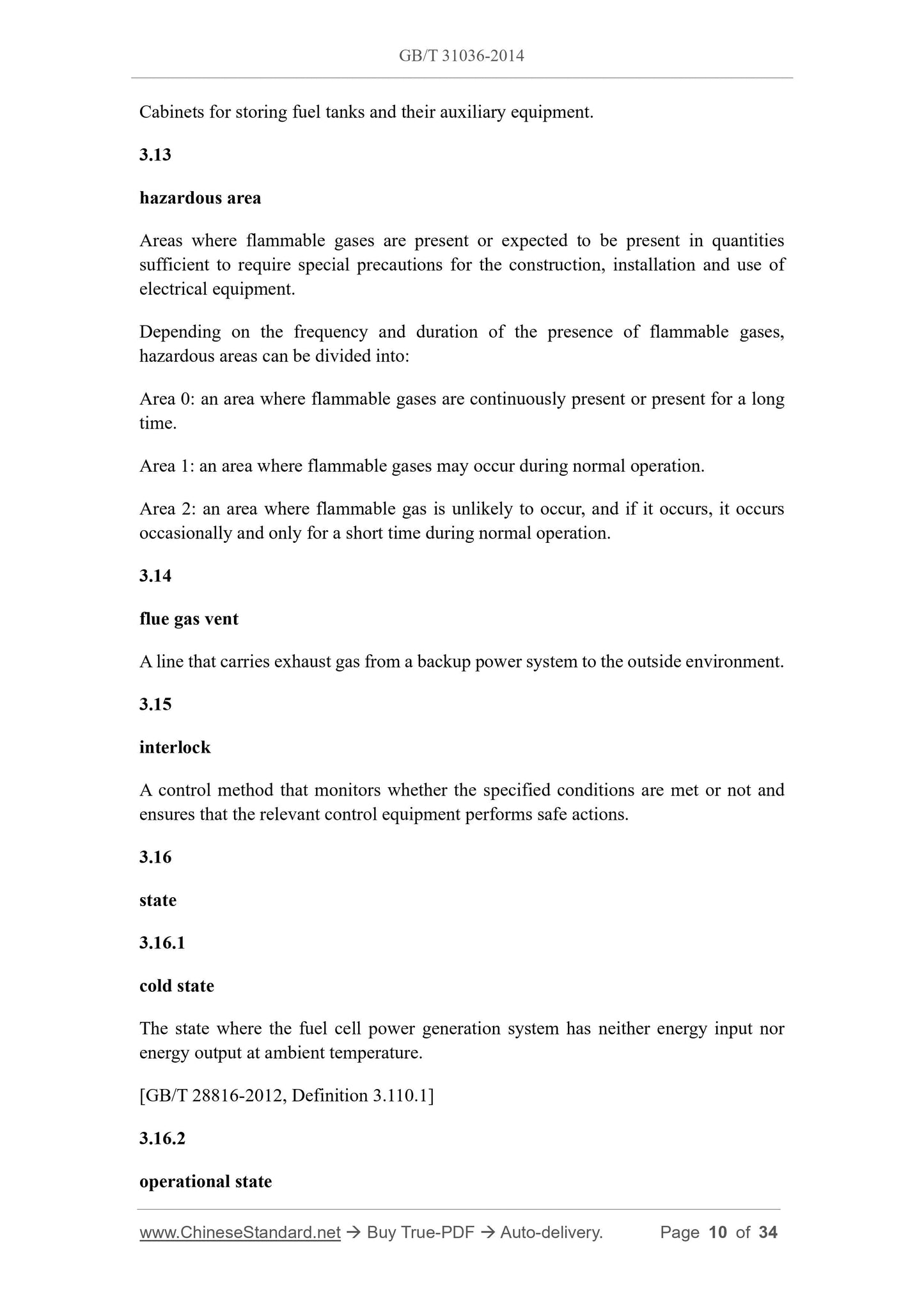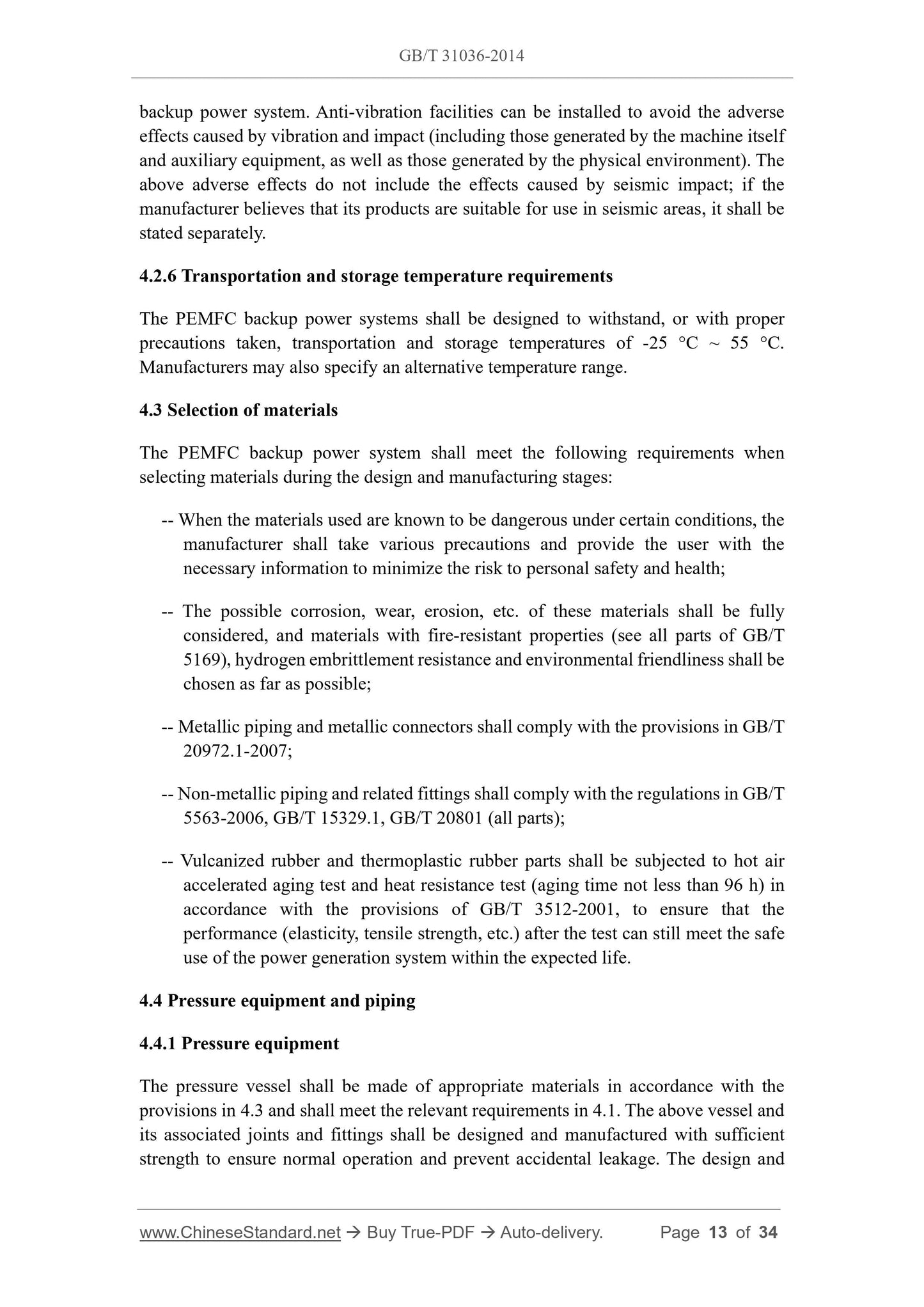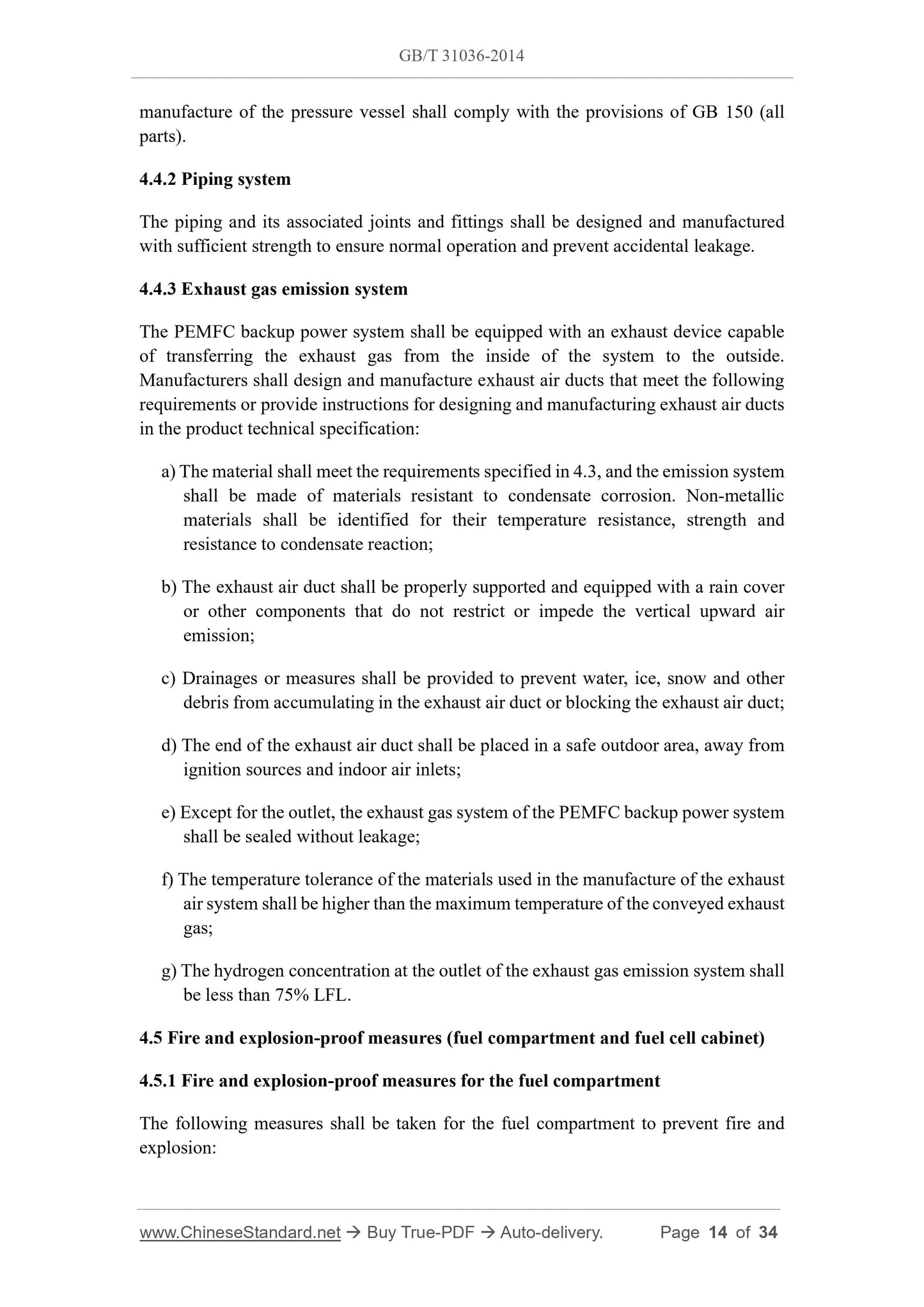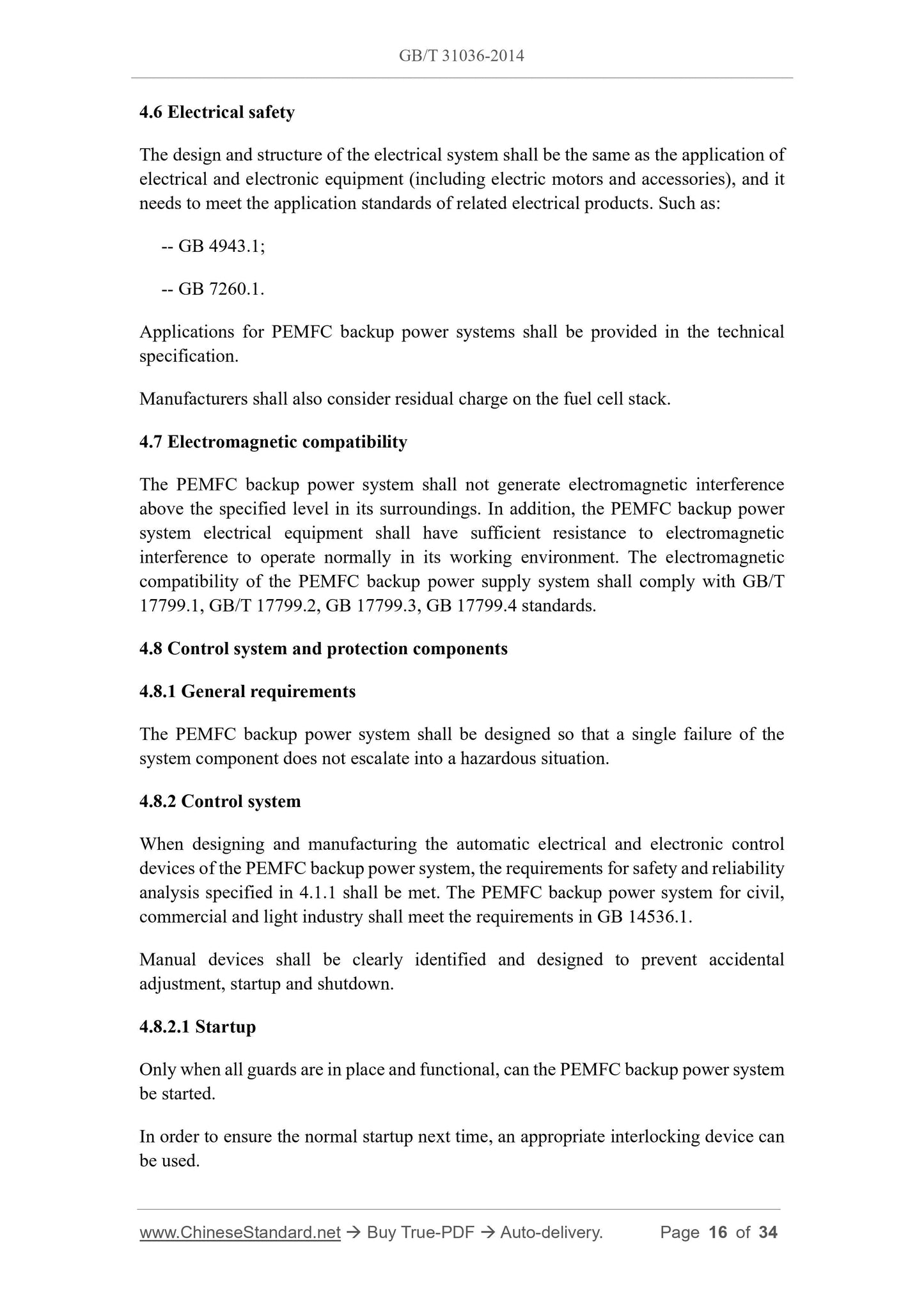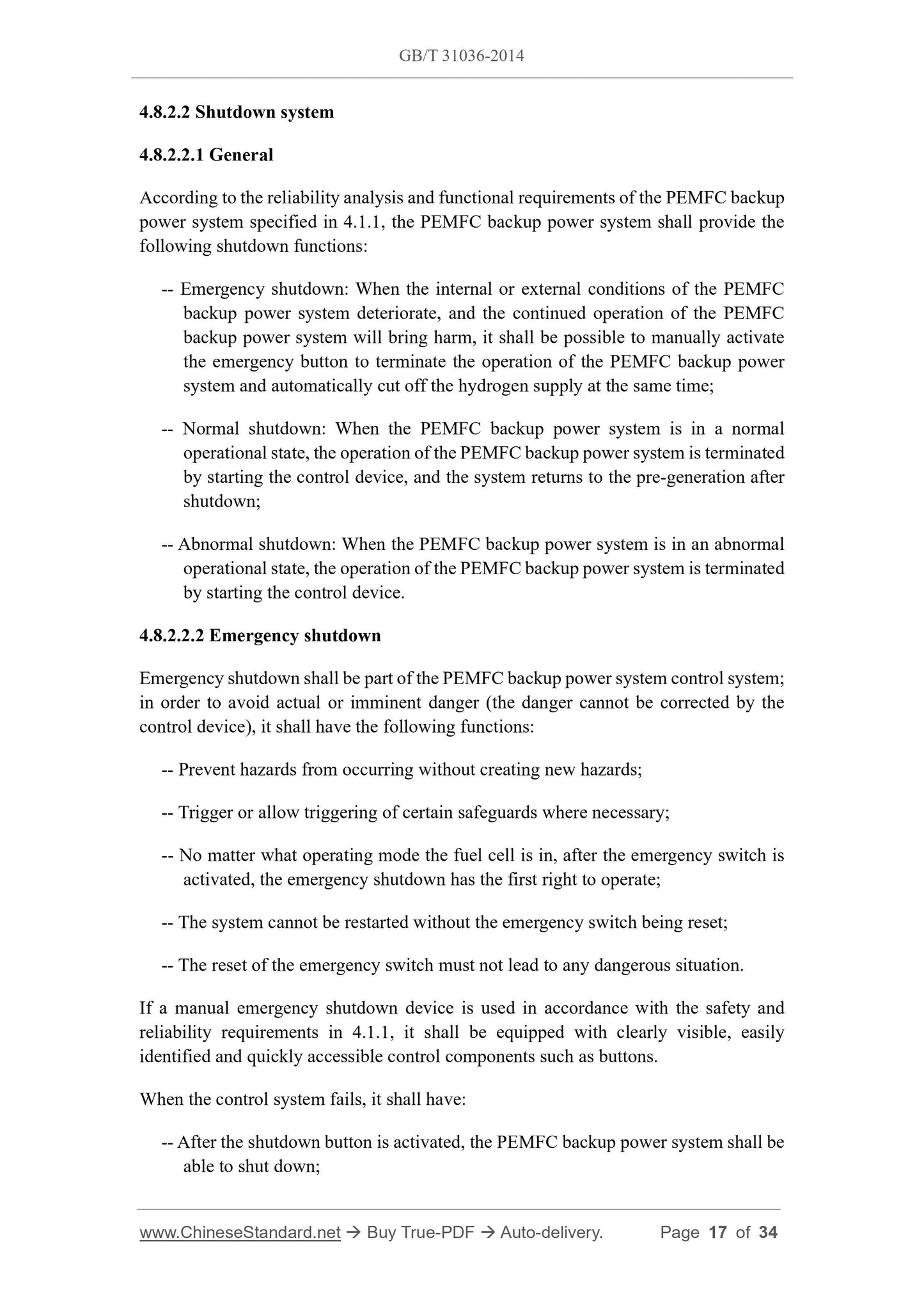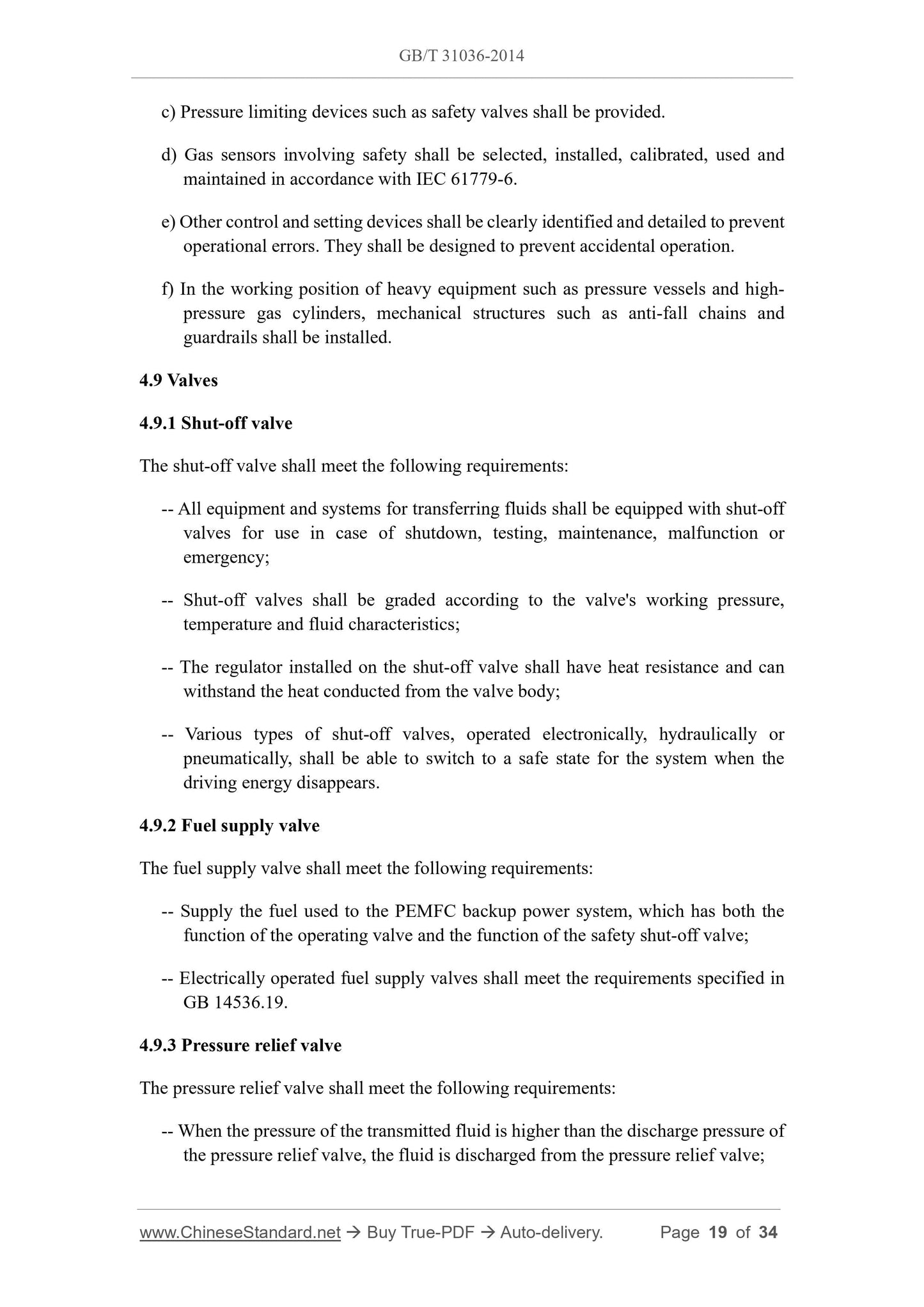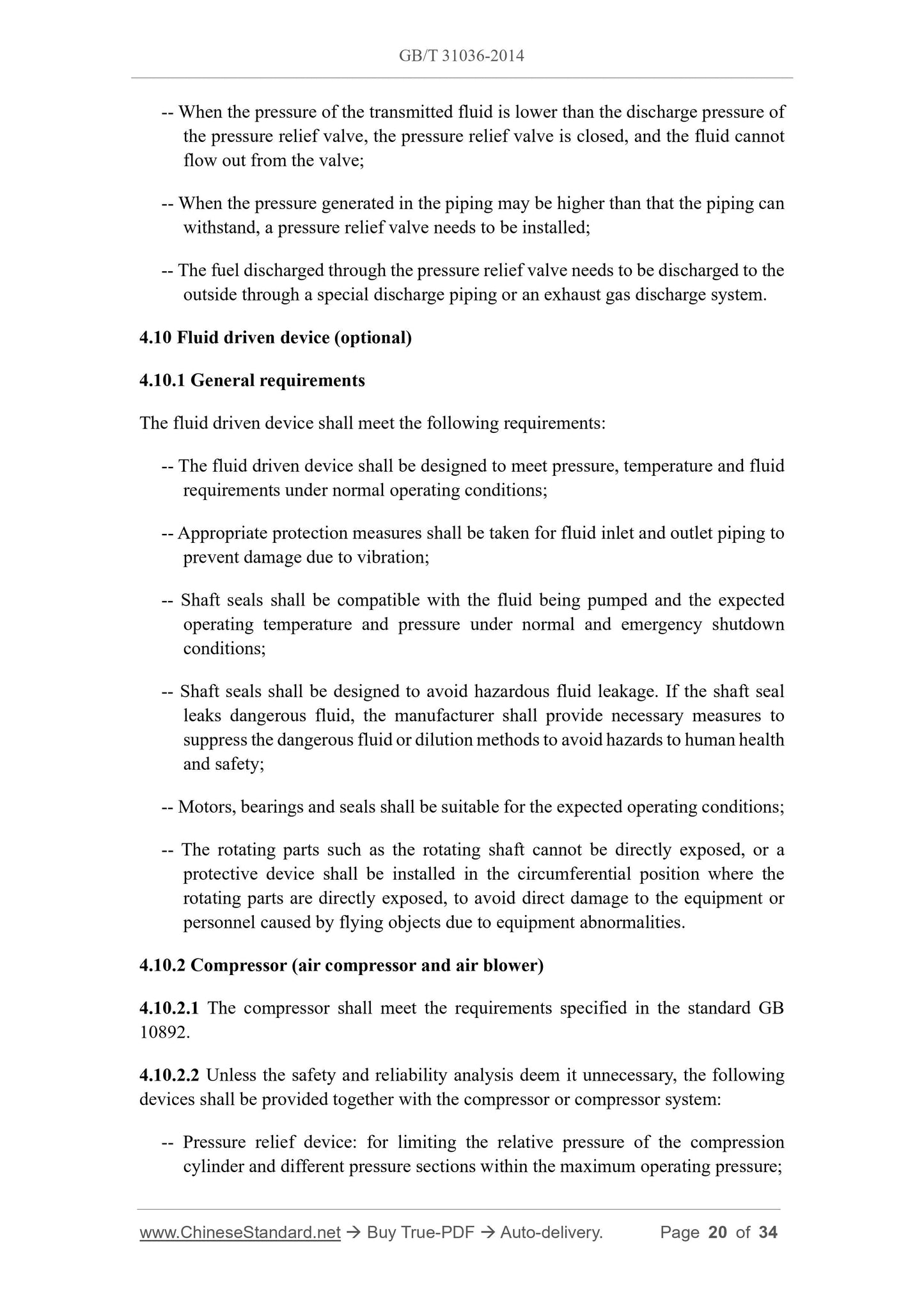1
/
of
12
www.ChineseStandard.us -- Field Test Asia Pte. Ltd.
GB/T 31036-2014 English PDF (GB/T31036-2014)
GB/T 31036-2014 English PDF (GB/T31036-2014)
Regular price
$315.00
Regular price
Sale price
$315.00
Unit price
/
per
Shipping calculated at checkout.
Couldn't load pickup availability
GB/T 31036-2014: Proton exchange membrane fuel cell backup power system - Safety
Delivery: 9 seconds. Download (& Email) true-PDF + Invoice.
Get Quotation: Click GB/T 31036-2014 (Self-service in 1-minute)
Historical versions (Master-website): GB/T 31036-2014
Preview True-PDF (Reload/Scroll-down if blank)
GB/T 31036-2014
NATIONAL STANDARD OF THE
PEOPLE’S REPUBLIC OF CHINA
ICS 27.070
K 82
GB 31036-2014
Proton exchange membrane fuel cell backup power system -
Safety
ISSUED ON: DECEMBER 05, 2014
IMPLEMENTED ON: JULY 01, 2015
Issued by: General Administration of Quality Supervision, Inspection and
Quarantine;
Standardization Administration of the People’s Republic of China.
Table of Contents
FOREWORD ... 3
1 Scope ... 4
2 Normative references ... 6
3 Terms and definitions... 7
4 Safety requirements and protective measures ... 11
5 Type tests ... 22
6 Routine tests ... 31
7 Marking, labeling and packaging ... 32
Appendix A (Informative) Important hazards, hazardous situations and events involved
in this Standard ... 33
Proton exchange membrane fuel cell backup power system -
Safety
1 Scope
This Standard specifies terms and definitions, safety requirements and protective
measures, type tests, routine tests, and marking, labeling and packaging related to the
proton exchange membrane fuel cell backup power system.
This Standard applies to the proton exchange membrane fuel cell backup power system
(hereinafter referred to as PEMFC backup power system), including:
-- PEMFC backup power system providing AC or DC power;
-- PEMFC backup power system using hydrogen and air as reactant gases.
Safety requirements for the installation site are not specified in this Standard.
Figure 1 is a schematic diagram of the boundary of a typical PEMFC backup power
system.
The PEMFC backup power system applicable to this Standard shall constitute a
complete system. In order to achieve the set function, the system shall be composed of
some or all of the following components:
-- Fuel storage and supply system: a system that is used for storing fuel used by the
PEMFC backup power system and providing fuel for the PEMFC backup power
system;
-- Air supply system: a system that is used for metering, conditioning, processing
and pressurizing the air required by the PEMFC backup power system;
-- Thermal management system: a system that provides cooling, heat dissipation,
and/or heating functions to maintain thermal balance within the PEMFC backup
power system;
-- Water treatment systems: a system that treats and purifies the recovered or added
water for use by the PEMFC backup power system;
-- Electrical output conditioning system: a system that controls or converts the
generated electrical energy to meet the electrical demand within the
manufacturer's design range;
-- Automatic control system: a system consisting of sensors, actuators, valves,
switches, logic elements and control boards, etc., which is used for maintaining
the parameters of the PEMFC backup power system, without manual intervention,
within the range set by the manufacturer;
-- Ventilation system: a system that realizes the air exchange inside and outside the
cabinet of the PEMFC backup power system by means of forced or natural
ventilation;
-- Fuel cell module: a module consisting of one or more fuel cell stacks, electrical
connection devices for delivering electrical energy to the stacks, and monitoring
devices, which converts chemical energy into electrical energy and thermal
energy.
-- Auxiliary energy storage device: a rechargeable and dischargeable energy storage
device inside the system, which is used for assisting or supplementing the fuel
cell module to supply power to internal or external loads. (Optional)
This Standard applies to commercial, industrial and domestic PEMFC backup power
systems in non-hazardous (unclassified) areas around the equipment.
This Standard only considers dangerous situations that may cause harm to persons,
objects or the environment outside the PEMFC backup power system, and proposes
safety requirements for such dangerous situations, excluding the safety measures that
may be taken when the PEMFC backup power system itself may be damaged. The
prerequisites in this part are not intended to limit innovation. When materials, designs
or manufactures different from this part are used, they shall have the same or equivalent
safety and performance with those specified in this part.
concentration is lower than critical ratio of the low flammability limit (LFL) or
higher than the high flammability limit (UFL), it will not initiate combustion.
3.2
thermal stability
Stable temperature conditions, quasi-steady state. Read the temperature twice at an
interval of 15 minutes; in any state where the temperature change does not exceed 3 °C
or 1% of the absolute operating temperature, the temperature with the higher reading
shall prevail.
3.3
accessible areas
Under normal operating conditions, an area that meets one of the following factors:
a) It is accessible without the use of tools;
b) It is accessible after the operator is specially provided with an access method;
c) Whether or not the use of tools is required, the operator can be guided to access.
Note 1: Unless otherwise defined, the terms "access" and "accessibility" refer only to
the operator's access to the area in the above definition.
Note 2: Only maintenance personnel can enter the inaccessible area. When entering the
inaccessible area, the maintenance personnel may need to take appropriate
personal protection according to the maintenance manual.
3.4
combustible materials
Burnable materials.
Note: Combustible materials shall also be considered combustible after being
refractory treated, flame retardant treated or plastered.
3.5
design pressure
The maximum pressure value in all operating modes, including steady state and
transient state.
3.6
Cabinets for storing fuel tanks and their auxiliary equipment.
3.13
hazardous area
Areas where flammable gases are present or expected to be present in quantities
sufficient to require special precautions for the construction, installation and use of
electrical equipment.
Depending on the frequency and duration of the presence of flammable gases,
hazardous areas can be divided into:
Area 0: an area where flammable gases are continuously present or present for a long
time.
Area 1: an area where flammable gases may occur during normal operation.
Area 2: an area where flammable gas is unlikely to occur, and if it occurs, it occurs
occasionally and only for a short time during normal operation.
3.14
flue gas vent
A line that carries exhaust gas from a backup power system to the outside environment.
3.15
interlock
A control method that monitors whether the specified conditions are met or not and
ensures that the relevant control equipment performs safe actions.
3.16
state
3.16.1
cold state
The state where the fuel cell power generation system has neither energy input nor
energy output at ambient temperature.
[GB/T 28816-2012, Definition 3.110.1]
3.16.2
operational state
backup power system. Anti-vibration facilities can be installed to avoid the adverse
effects caused by vibration and impact (including those generated by the machine itself
and auxiliary equipment, as well as those generated by the physical environment). The
above adverse effects do not include the effects caused by seismic impact; if the
manufacturer believes that its products are suitable for use in seismic areas, it shall be
stated separately.
4.2.6 Transportation and storage temperature requirements
The PEMFC backup power systems shall be designed to withstand, or with proper
precautions taken, transportation and storage temperatures of -25 °C ~ 55 °C.
Manufacturers may also specify an alternative temperature range.
4.3 Selection of materials
The PEMFC backup power system shall meet the following requirements when
selecting materials during the design and manufacturing stages:
-- When the materials used are known to be dangerous under certain conditions, the
manufacturer shall take various precautions and provide the user with the
necessary information to minimize the risk to personal safety and health;
-- The possible corrosion, wear, erosion, etc. of these materials shall be fully
considered, and materials with fire-resistant properties (see all parts of GB/T
5169), hydrogen embrittlement resistance and environmental friendliness shall be
chosen as far as possible;
-- Metallic piping and metallic connectors shall comply with the provisions in GB/T
20972.1-2007;
-- Non-metallic piping and related fittings shall comply with the regulations in GB/T
5563-2006, GB/T 15329.1, GB/T 20801 (all parts);
-- Vulcanized rubber and thermoplastic rubber parts shall be subjected to hot air
accelerated aging test and heat resistance test (aging time not less than 96 h) in
accordance with the provisions of GB/T 3512-2001, to ensure that the
performance (elasticity, tensile strength, etc.) after the test can still meet the safe
use of the power generation system within the expected life.
4.4 Pressure equipment and piping
4.4.1 Pressure equipment
The pressure vessel shall be made of appropriate materials in accordance with the
provisions in 4.3 and shall meet the relevant requirements in 4.1. The above vessel and
its associated joints and fittings shall be designed and manufactured with sufficient
strength to ensure normal operation and prevent accidental leakage. The design and
manufacture of the pressure vessel shall comply with the provisions of GB 150 (all
parts).
4.4.2 Piping system
The piping and its associated joints and fittings shall be designed and manufactured
with sufficient strength to ensure normal operation and prevent accidental leakage.
4.4.3 Exhaust gas emission system
The PEMFC backup power system shall be equipped with an exhaust device capable
of transferring the exhaust gas from the inside of the system to the outside.
Manufacturers shall design and manufacture exhaust air ducts that meet the following
requirements or provide instructions for designing and manufacturing exhaust air ducts
in the product technical specification:
a) The material shall meet the requirements specified in 4.3, and the emission system
shall be made of materials resistant to condensate corrosion. Non-metallic
materials shall be identified for their temperature resistance, strength and
resistance to condensate reaction;
b) The exhaust air duct shall be properly supported and equipped with a rain cover
or other components that do not restrict or impede the vertical upward air
emission;
c) Drainages or measures shall be provided to prevent water, ice, snow and other
debris from accumulating in the exhaust air duct or blocking the exhaust air duct;
d) The end of the exhaust air duct shall be placed in a safe outdoor area, away from
ignition sources and indoor air inlets;
e) Except for the outlet, the exhaust gas system of the PEMFC backup power system
shall be sealed without leakage;
f) The temperature tolerance of the materials used in the manufacture of the exhaust
air system shall be higher than the maximum temperature of the conveyed exhaust
gas;
g) The hydrogen concentration at the outlet of the exhaust gas emission system shall
be less than 75% LFL.
4.5 Fire and explosion-proof measures (fuel compartment and fuel cell cabinet)
4.5.1 Fire and explosion-proof measures for the fuel compartment
The following measures shall be taken for the fuel compartment to prevent fire and
explosion:
4.6 Electrical safety
The design and structure of the electrical system shall be the same as the application of
electrical and electronic equipment (including electric motors and accessories), and it
needs to meet the application standards of related electrical products. Such as:
-- GB 4943.1;
-- GB 7260.1.
Applications for PEMFC backup power systems shall be provided in the technical
specification.
Manufacturers shall also consider residual charge on the fuel cell stack.
4.7 Electromagnetic compatibility
The PEMFC backup power system shall not generate electromagnetic interference
above the specified level in its surroundings. In addition, the PEMFC backup power
system electrical equipment shall have sufficient resistance to electromagnetic
interference to operate normally in its working environment. The electromagnetic
compatibility of the PEMFC backup power supply system shall comply with GB/T
17799.1, GB/T 17799.2, GB 17799.3, GB 17799.4 standards.
4.8 Control system and protection components
4.8.1 General requirements
The PEMFC backup power system shall be designed so that a single failure of the
system component does not escalate into a hazardous situation.
4.8.2 Control system
When designing and manufacturing the automatic electrical and electronic control
devices of the PEMFC backup power system, the requirements for safety and reliability
analysis specified in 4.1.1 shall be met. The PEMFC backup power system for civil,
commercial and light industry shall meet the requirements in GB 14536.1.
Manual devices shall be clearly identified and designed to prevent accidental
adjustment, startup and shutdown.
4.8.2.1 Startup
Only when all guards are in place and functional, can the PEMFC backup power system
be started.
In order to ensure the normal startup next time, an appropriate interlocking device can
be used.
4.8.2.2 Shutdown system
4.8.2.2.1 General
According to the reliability analysis and functional requirements of the PEMFC backup
power system specified in 4.1.1, the PEMFC backup power system shall provide the
following shutdown functions:
-- Emergency shutdown: When the internal or external conditions of the PEMFC
backup power system deteriorate, and the continued operation of the PEMFC
backup power system will bring harm, it shall be possible to manually activate
the emergency button to terminate the operation of the PEMFC backup power
system and automatically cut off the hydrogen supply at the same time;
-- Normal shutdown: When the PEMFC backup power system is in a normal
operational state, the operation of the PEMFC ...
Delivery: 9 seconds. Download (& Email) true-PDF + Invoice.
Get Quotation: Click GB/T 31036-2014 (Self-service in 1-minute)
Historical versions (Master-website): GB/T 31036-2014
Preview True-PDF (Reload/Scroll-down if blank)
GB/T 31036-2014
NATIONAL STANDARD OF THE
PEOPLE’S REPUBLIC OF CHINA
ICS 27.070
K 82
GB 31036-2014
Proton exchange membrane fuel cell backup power system -
Safety
ISSUED ON: DECEMBER 05, 2014
IMPLEMENTED ON: JULY 01, 2015
Issued by: General Administration of Quality Supervision, Inspection and
Quarantine;
Standardization Administration of the People’s Republic of China.
Table of Contents
FOREWORD ... 3
1 Scope ... 4
2 Normative references ... 6
3 Terms and definitions... 7
4 Safety requirements and protective measures ... 11
5 Type tests ... 22
6 Routine tests ... 31
7 Marking, labeling and packaging ... 32
Appendix A (Informative) Important hazards, hazardous situations and events involved
in this Standard ... 33
Proton exchange membrane fuel cell backup power system -
Safety
1 Scope
This Standard specifies terms and definitions, safety requirements and protective
measures, type tests, routine tests, and marking, labeling and packaging related to the
proton exchange membrane fuel cell backup power system.
This Standard applies to the proton exchange membrane fuel cell backup power system
(hereinafter referred to as PEMFC backup power system), including:
-- PEMFC backup power system providing AC or DC power;
-- PEMFC backup power system using hydrogen and air as reactant gases.
Safety requirements for the installation site are not specified in this Standard.
Figure 1 is a schematic diagram of the boundary of a typical PEMFC backup power
system.
The PEMFC backup power system applicable to this Standard shall constitute a
complete system. In order to achieve the set function, the system shall be composed of
some or all of the following components:
-- Fuel storage and supply system: a system that is used for storing fuel used by the
PEMFC backup power system and providing fuel for the PEMFC backup power
system;
-- Air supply system: a system that is used for metering, conditioning, processing
and pressurizing the air required by the PEMFC backup power system;
-- Thermal management system: a system that provides cooling, heat dissipation,
and/or heating functions to maintain thermal balance within the PEMFC backup
power system;
-- Water treatment systems: a system that treats and purifies the recovered or added
water for use by the PEMFC backup power system;
-- Electrical output conditioning system: a system that controls or converts the
generated electrical energy to meet the electrical demand within the
manufacturer's design range;
-- Automatic control system: a system consisting of sensors, actuators, valves,
switches, logic elements and control boards, etc., which is used for maintaining
the parameters of the PEMFC backup power system, without manual intervention,
within the range set by the manufacturer;
-- Ventilation system: a system that realizes the air exchange inside and outside the
cabinet of the PEMFC backup power system by means of forced or natural
ventilation;
-- Fuel cell module: a module consisting of one or more fuel cell stacks, electrical
connection devices for delivering electrical energy to the stacks, and monitoring
devices, which converts chemical energy into electrical energy and thermal
energy.
-- Auxiliary energy storage device: a rechargeable and dischargeable energy storage
device inside the system, which is used for assisting or supplementing the fuel
cell module to supply power to internal or external loads. (Optional)
This Standard applies to commercial, industrial and domestic PEMFC backup power
systems in non-hazardous (unclassified) areas around the equipment.
This Standard only considers dangerous situations that may cause harm to persons,
objects or the environment outside the PEMFC backup power system, and proposes
safety requirements for such dangerous situations, excluding the safety measures that
may be taken when the PEMFC backup power system itself may be damaged. The
prerequisites in this part are not intended to limit innovation. When materials, designs
or manufactures different from this part are used, they shall have the same or equivalent
safety and performance with those specified in this part.
concentration is lower than critical ratio of the low flammability limit (LFL) or
higher than the high flammability limit (UFL), it will not initiate combustion.
3.2
thermal stability
Stable temperature conditions, quasi-steady state. Read the temperature twice at an
interval of 15 minutes; in any state where the temperature change does not exceed 3 °C
or 1% of the absolute operating temperature, the temperature with the higher reading
shall prevail.
3.3
accessible areas
Under normal operating conditions, an area that meets one of the following factors:
a) It is accessible without the use of tools;
b) It is accessible after the operator is specially provided with an access method;
c) Whether or not the use of tools is required, the operator can be guided to access.
Note 1: Unless otherwise defined, the terms "access" and "accessibility" refer only to
the operator's access to the area in the above definition.
Note 2: Only maintenance personnel can enter the inaccessible area. When entering the
inaccessible area, the maintenance personnel may need to take appropriate
personal protection according to the maintenance manual.
3.4
combustible materials
Burnable materials.
Note: Combustible materials shall also be considered combustible after being
refractory treated, flame retardant treated or plastered.
3.5
design pressure
The maximum pressure value in all operating modes, including steady state and
transient state.
3.6
Cabinets for storing fuel tanks and their auxiliary equipment.
3.13
hazardous area
Areas where flammable gases are present or expected to be present in quantities
sufficient to require special precautions for the construction, installation and use of
electrical equipment.
Depending on the frequency and duration of the presence of flammable gases,
hazardous areas can be divided into:
Area 0: an area where flammable gases are continuously present or present for a long
time.
Area 1: an area where flammable gases may occur during normal operation.
Area 2: an area where flammable gas is unlikely to occur, and if it occurs, it occurs
occasionally and only for a short time during normal operation.
3.14
flue gas vent
A line that carries exhaust gas from a backup power system to the outside environment.
3.15
interlock
A control method that monitors whether the specified conditions are met or not and
ensures that the relevant control equipment performs safe actions.
3.16
state
3.16.1
cold state
The state where the fuel cell power generation system has neither energy input nor
energy output at ambient temperature.
[GB/T 28816-2012, Definition 3.110.1]
3.16.2
operational state
backup power system. Anti-vibration facilities can be installed to avoid the adverse
effects caused by vibration and impact (including those generated by the machine itself
and auxiliary equipment, as well as those generated by the physical environment). The
above adverse effects do not include the effects caused by seismic impact; if the
manufacturer believes that its products are suitable for use in seismic areas, it shall be
stated separately.
4.2.6 Transportation and storage temperature requirements
The PEMFC backup power systems shall be designed to withstand, or with proper
precautions taken, transportation and storage temperatures of -25 °C ~ 55 °C.
Manufacturers may also specify an alternative temperature range.
4.3 Selection of materials
The PEMFC backup power system shall meet the following requirements when
selecting materials during the design and manufacturing stages:
-- When the materials used are known to be dangerous under certain conditions, the
manufacturer shall take various precautions and provide the user with the
necessary information to minimize the risk to personal safety and health;
-- The possible corrosion, wear, erosion, etc. of these materials shall be fully
considered, and materials with fire-resistant properties (see all parts of GB/T
5169), hydrogen embrittlement resistance and environmental friendliness shall be
chosen as far as possible;
-- Metallic piping and metallic connectors shall comply with the provisions in GB/T
20972.1-2007;
-- Non-metallic piping and related fittings shall comply with the regulations in GB/T
5563-2006, GB/T 15329.1, GB/T 20801 (all parts);
-- Vulcanized rubber and thermoplastic rubber parts shall be subjected to hot air
accelerated aging test and heat resistance test (aging time not less than 96 h) in
accordance with the provisions of GB/T 3512-2001, to ensure that the
performance (elasticity, tensile strength, etc.) after the test can still meet the safe
use of the power generation system within the expected life.
4.4 Pressure equipment and piping
4.4.1 Pressure equipment
The pressure vessel shall be made of appropriate materials in accordance with the
provisions in 4.3 and shall meet the relevant requirements in 4.1. The above vessel and
its associated joints and fittings shall be designed and manufactured with sufficient
strength to ensure normal operation and prevent accidental leakage. The design and
manufacture of the pressure vessel shall comply with the provisions of GB 150 (all
parts).
4.4.2 Piping system
The piping and its associated joints and fittings shall be designed and manufactured
with sufficient strength to ensure normal operation and prevent accidental leakage.
4.4.3 Exhaust gas emission system
The PEMFC backup power system shall be equipped with an exhaust device capable
of transferring the exhaust gas from the inside of the system to the outside.
Manufacturers shall design and manufacture exhaust air ducts that meet the following
requirements or provide instructions for designing and manufacturing exhaust air ducts
in the product technical specification:
a) The material shall meet the requirements specified in 4.3, and the emission system
shall be made of materials resistant to condensate corrosion. Non-metallic
materials shall be identified for their temperature resistance, strength and
resistance to condensate reaction;
b) The exhaust air duct shall be properly supported and equipped with a rain cover
or other components that do not restrict or impede the vertical upward air
emission;
c) Drainages or measures shall be provided to prevent water, ice, snow and other
debris from accumulating in the exhaust air duct or blocking the exhaust air duct;
d) The end of the exhaust air duct shall be placed in a safe outdoor area, away from
ignition sources and indoor air inlets;
e) Except for the outlet, the exhaust gas system of the PEMFC backup power system
shall be sealed without leakage;
f) The temperature tolerance of the materials used in the manufacture of the exhaust
air system shall be higher than the maximum temperature of the conveyed exhaust
gas;
g) The hydrogen concentration at the outlet of the exhaust gas emission system shall
be less than 75% LFL.
4.5 Fire and explosion-proof measures (fuel compartment and fuel cell cabinet)
4.5.1 Fire and explosion-proof measures for the fuel compartment
The following measures shall be taken for the fuel compartment to prevent fire and
explosion:
4.6 Electrical safety
The design and structure of the electrical system shall be the same as the application of
electrical and electronic equipment (including electric motors and accessories), and it
needs to meet the application standards of related electrical products. Such as:
-- GB 4943.1;
-- GB 7260.1.
Applications for PEMFC backup power systems shall be provided in the technical
specification.
Manufacturers shall also consider residual charge on the fuel cell stack.
4.7 Electromagnetic compatibility
The PEMFC backup power system shall not generate electromagnetic interference
above the specified level in its surroundings. In addition, the PEMFC backup power
system electrical equipment shall have sufficient resistance to electromagnetic
interference to operate normally in its working environment. The electromagnetic
compatibility of the PEMFC backup power supply system shall comply with GB/T
17799.1, GB/T 17799.2, GB 17799.3, GB 17799.4 standards.
4.8 Control system and protection components
4.8.1 General requirements
The PEMFC backup power system shall be designed so that a single failure of the
system component does not escalate into a hazardous situation.
4.8.2 Control system
When designing and manufacturing the automatic electrical and electronic control
devices of the PEMFC backup power system, the requirements for safety and reliability
analysis specified in 4.1.1 shall be met. The PEMFC backup power system for civil,
commercial and light industry shall meet the requirements in GB 14536.1.
Manual devices shall be clearly identified and designed to prevent accidental
adjustment, startup and shutdown.
4.8.2.1 Startup
Only when all guards are in place and functional, can the PEMFC backup power system
be started.
In order to ensure the normal startup next time, an appropriate interlocking device can
be used.
4.8.2.2 Shutdown system
4.8.2.2.1 General
According to the reliability analysis and functional requirements of the PEMFC backup
power system specified in 4.1.1, the PEMFC backup power system shall provide the
following shutdown functions:
-- Emergency shutdown: When the internal or external conditions of the PEMFC
backup power system deteriorate, and the continued operation of the PEMFC
backup power system will bring harm, it shall be possible to manually activate
the emergency button to terminate the operation of the PEMFC backup power
system and automatically cut off the hydrogen supply at the same time;
-- Normal shutdown: When the PEMFC backup power system is in a normal
operational state, the operation of the PEMFC ...
Share
